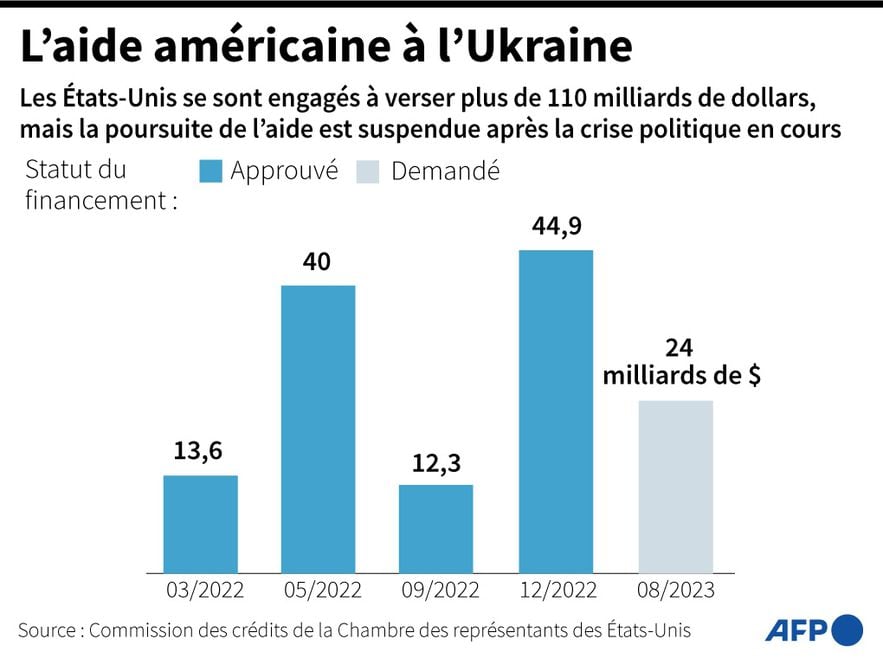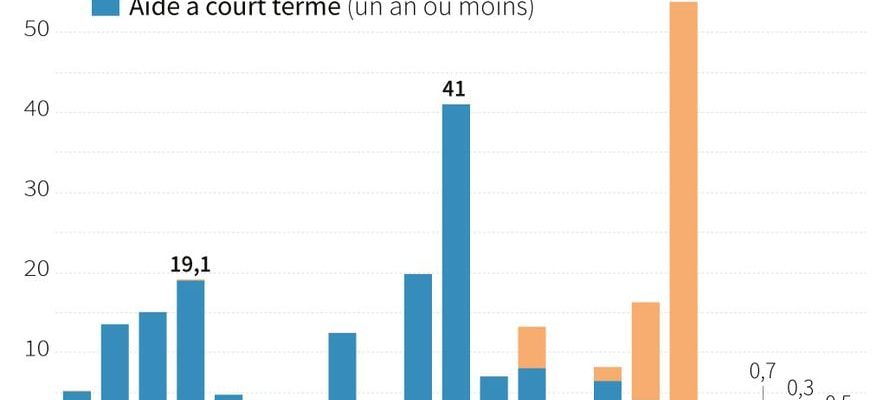This is the “lowest” quarterly amount since the start of the Russian invasion of Ukraine. New promises of Western aid to Ukraine have slowed down sharply, against a backdrop of political dissension in Europe and the United States, the Kiel Institute, a German research establishment, said on Thursday, December 7.
“The dynamic of support for Ukraine is slowing down. Aid pledges reached their lowest level between August and October 2023 – a drop of almost 90% compared to the same period in 2022,” details the institute, which lists the military, financial and humanitarian aid promised and delivered to Ukraine since the Russian invasion on February 24, 2022. According to data from the Kiel Institute, new commitments made between the beginning of August and the end of October amount to 2, 11 billion euros, a figure down 87% compared to the same period in 2022.
“The outlook is uncertain”
In total, since the start of the war, Ukraine’s allies and major international organizations (World Bank, IMF, etc.) have promised it nearly 255 billion euros in aid, including 182 billion in the short term (already delivered or planned within one year). These commitments include 141 billion euros in financial aid, nearly 16 billion in humanitarian aid and 98 billion in military aid.
Over the period from August to October 2023, among the 42 donor countries monitored by the institute, “only 20 have committed to new aid packages”, and the new commitments from the European Union and the United States were “limited”. “The outlook is uncertain,” the institute says, “since the largest pending commitment – from the European Union – has not been approved and aid from the United States is declining.”
According to data from the Kiel Institute, new commitments made between the beginning of August and the end of October amount to 2.11 billion euros, a figure down 87% compared to the same period in 2022.
© / Laurence SAUBADU, Sylvie HUSSON / AFP
The United States ahead of Germany
In terms of military aid alone, the European Union and NATO countries have already committed 98 billion euros at the end of October, according to the Kiel Institute. In detail, Europe in the broad sense (including the United Kingdom, Norway and Turkey) has promised 51.5 billion; the United States 43.9 billion. But the European promises are spread over several years while those of the United States have all already been delivered or will be within a year. For short-term promises (within 12 months), Europe, with 36.3 billion euros, is behind the United States.
By country, the United States is followed by Germany (17.1 billion, including 6.6 billion in the short term) and the United Kingdom (6.6 billion, entirely in the short term). Berlin also announced at the end of November an additional envelope of 1.3 billion euros.
“Given the uncertainty surrounding continued US aid, Ukraine can only hope that the EU finally adopts its long-announced €50 billion support package. A further delay would clearly strengthen Vladimir Putin’s position”, warns Christoph Trebesch, who heads the Kiel Institute team monitoring aid to Ukraine.
A new American envelope blocked in Congress
An envelope of 50 billion euros envisaged to consolidate European support for Ukraine is blocked by the reluctance of certain European countries to disburse more, just like the new American envelope, which is paralyzed in Congress.

American aid to Ukraine
© / afp.com/Corin FAIFE
He failed on Wednesday to move forward on aid of more than $106 billion insisted on by Joe Biden, including funds for Ukraine and Israel. The Republican opposition refused to support this text at the heart of very acrimonious negotiations, demanding significant concessions on the migration policy of the United States in exchange for its votes. Political divisions are jeopardizing American financial support, a disaster scenario for kyiv whose summer counter-offensive has not brought the hoped-for territorial gains.
The release of funding to support Ukraine “can no longer wait” in the face of the danger represented by Vladimir Putin, warned Joe Biden while addressing elected officials in the American Congress. The failure of a vote on additional funds would be “the greatest gift” offered to the Russian president, added the American president, affirming that the master of the Kremlin, if he succeeded in seizing Ukraine, “won’t stop there.”
The United States is currently the country providing the largest military support to Ukraine. Congress has committed more than $110 billion since the Russian invasion in February 2022.
